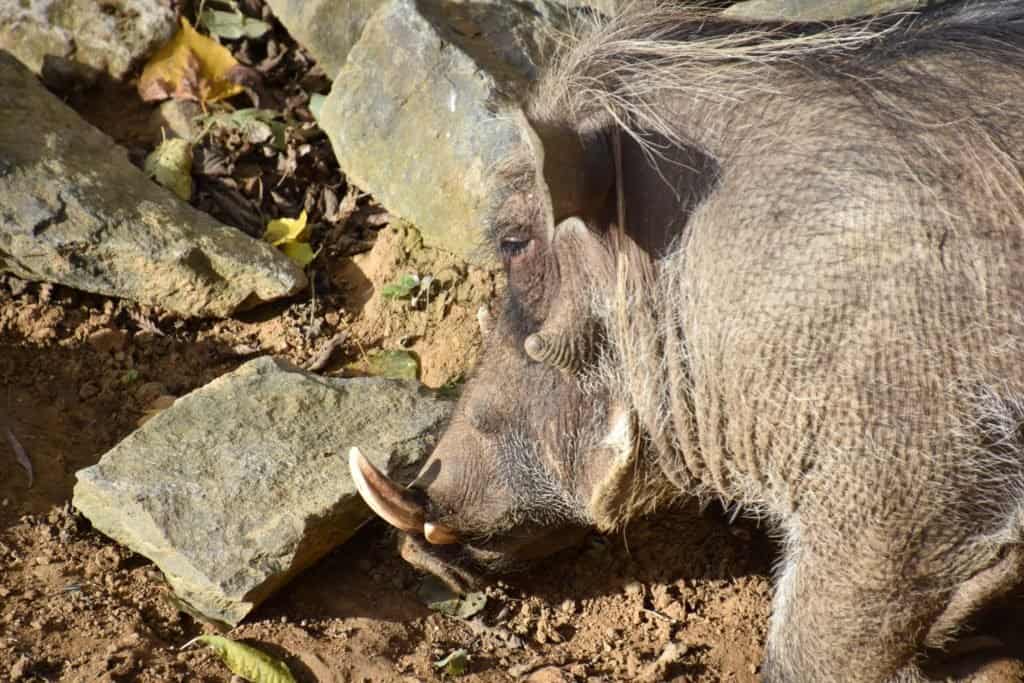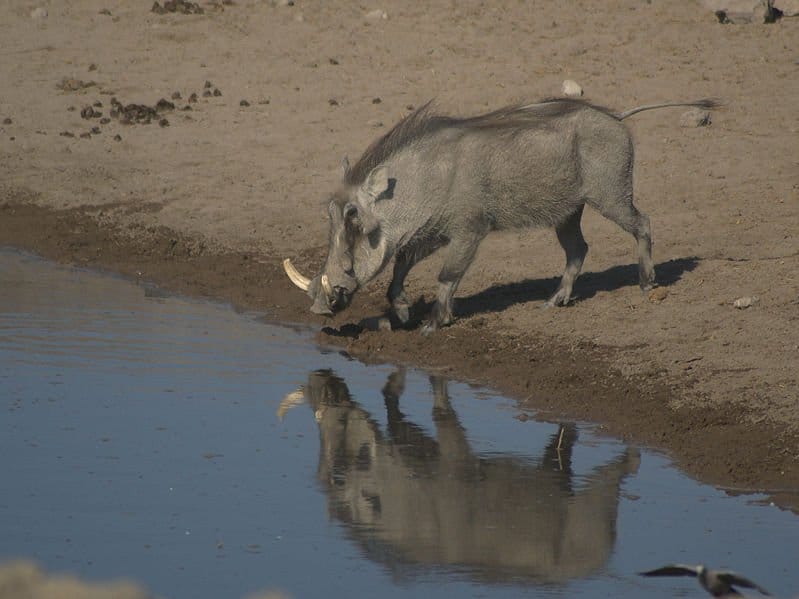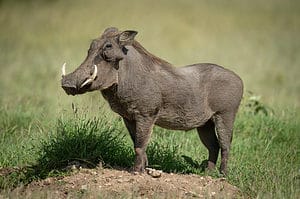Warthogs became pop-culture icons after The Lion King was released, but these creatures are quite different than their animated appearances would have you believe. Still, they are incredibly interesting and are represented in two recognized species: the common warthog and the desert warthog. Like pigs, they are hardy and tough, but they do have their own specialized diets that fit their ecosystems. Let’s take a deeper look at them to learn: what do warthogs eat?
What do warthogs eat?

Warthogs are omnivores that primarily eat grasses, roots, tubers, and bulbs.
©Wim Hoek/Shutterstock.com
Warthogs eat grasses, plants, roots, and bulbs.There are two recognized species of warthog: the common warthog and the desert warthog. Still, it’s possible to break each of the primary species into subspecies, but the primary dietary differences (and similarities) can be found higher up the classification.
Common warthog
The common warthog is the only known species of pig that is specially adapted to live in the savanna. Savannas are expansive grasslands, and the diets of the common warthog reflect this. Common warthogs are omnivorous and will eat almost anything. Their diet is mostly grasses, roots, berries, and bark, but they are known to eat fruit, fungi, insects, eggs, and even carrion.
Savanna grasslands experience cycles of dry and wet seasons, and common warthogs adapt as the climate changes. During the wet seasons, common foods include grasses and berries when they can find them. The rain often brings an abundance of food, allowing them to be a bit pickier in their choices.
During the dry season, common warthogs have to dig to find their food. The grasses die out, and berries and fruits aren’t growing. Warthogs are adept diggers and have an excellent sense of smell. Common foods during the dry season include bark, bulbs, roots, and tubers.
Desert warthog
Desert warthogs are far less common and only live around the Horn of Africa. Their habitat is mostly desert, and their dietary habits are suited to their dry environments. Although most pigs can be considered omnivorous, desert warthogs are mainly herbivorous. They travel in groups and forage daily for grasses, plants, flowers, fruits, and more. When there is less food (or less of their preferred foods), they will eat rhizomes, tubers, bulbs, bark, insects, and carrion.
Since desert warthogs generally live in tougher environments than common warthogs, they are less picky in their diet. When foods get really scarce, they are known to eat the dung of other animals, as well as their own.
A complete list of foods warthogs eat
Here is a complete list of foods that warthogs eat:
- grasses
- tubers
- roots
- bulbs
- rhizomes
- bark
- insects
- fruit
- leaves
- berries
- carrion (rarely)
- dung
Where do warthogs live?

Warthogs are grazers and look for food most of the day.
©Millie Bond – Copyright A-Z Animals
There are pig or hog species on almost every continent in the world. The common and desert warthog, however, are native to the African continent and have their own ranges within.
Common warthogs mostly live in sub-Saharan Africa and can be found almost everywhere there is open country and grasslands. They generally avoid wooded areas and don’t venture into deserts, steppes, or thickets, preferring large swaths of lands they can graze peacefully. Additionally, they are often found near water sources and live within the range of a perennial water source, especially during the dry season. While they do share habitat with the desert warthog, their overlap is minimal and mostly relegated to regions of Somalia and Kenya.
Desert warthogs are significantly less distributed than their common cousins. Adapted for the desert, these warthogs exclusively live around the Horn of Africa, mostly from southeastern Ethiopia through Somalia and south to Kenya. The species was present in the Cape Province but was rendered extinct in 1871. They generally stick to arid plains, as well as sparse woodlands. Scrubland and sand are also common environments for these animals to live.
How do warthogs get their food?

Warthogs use their hooves and snout to forage for tubers and roots in the dirt.
©Hans Hillewaert / CC BY-SA 4.0 – License
Warthogs are incredibly intelligent and have come up with some specially adapted ways to get their food. Both species have tusks, but they rarely use them for digging and primarily serve defensive purposes. Since most of their diet is centered around food that is underground, they are adept diggers. Using their strong sense of smell, they root through the dirt, looking for potential morsels. Once found, they use their hooves and snouts to dig up the roots and tubers.
A common feeding behavior for warthogs is to fold their front legs and waddle around with their snout close to the ground. This is done when feeding in order to get closer to the ground and be more comfortable. Additionally, it’s used to get close to the edge of a watering hole while they drink.
What animals eat warthogs?
Warthogs have a great many predators, especially being on the superpredator continent that is Africa.
Large cats are the most common predators for warthogs of both species. Lions, leopards, and cheetahs are the most common cats that regularly hunt them. Hyenas are also known to hunt warthogs, but only in packs. Additionally, crocodiles regularly prey on warthogs, mainly while drinking. Watering holes are essential for warthogs, and crocodiles often lurk near the edges of the water, waiting for an unsuspecting animal to wander near.
Lions are among the top predators for warthogs due to their ability to dig them out of their burrows. Warthogs burrow when predators are near, often negating the predator’s ability to reach them. A large lion, however, has no issue digging out a warthog to eat it.
Burrows are dug by the warthogs or coopted from another animal (such as an aardvark). When they feel threatened, they can run up to 35 mph in order to reach the burrow. The babies dive in the holes head first, but the adults back in, allowing them to defend the opening with their tusks. When a burrow isn’t near, a warthog will use its tusks to defend itself and can inflict serious damage.
The photo featured at the top of this post is © Villiers Steyn/Shutterstock.com
Thank you for reading! Have some feedback for us? Contact the AZ Animals editorial team.






